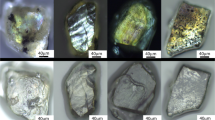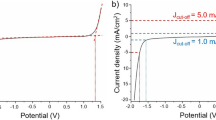Abstract
STUDIES of optical and electrical properties have shown that natural diamond can be broadly categorised into four types, types IA, IB, IIA and IIB (refs 1–3). Type IA is the most common (98% abundance)3 and contains up to 0.34% N (ref.16), which has been argued5 to occur in atom pairs. Type IB diamond contains much less N, of which 1–2% occurs as single substitutional paramagnetic N. Type II diamonds contain even less N. The p-type semiconducting property of type IIB diamond is due to the presence of B (refs 6, 7), the concentration of which has been correlated with the acceptor concentration7. We have determined and report here the impurity contents of 23 diamonds of different types in order to investigate whether elements other than N and B contribute to the physical properties of diamond. Although there are few diamonds of each type and the statistics are therefore poor, two diamonds were found to contain an excess of Ni, while the three Type IIB diamonds possibly contained an excess of Al.
This is a preview of subscription content, access via your institution
Access options
Subscribe to this journal
Receive 51 print issues and online access
$199.00 per year
only $3.90 per issue
Buy this article
- Purchase on Springer Link
- Instant access to full article PDF
Prices may be subject to local taxes which are calculated during checkout
Similar content being viewed by others
References
Robertson, R., Fox, J. F. & Martin, A. E. Phil. Trans. R. Soc. A232, 463–535 (1934).
Custers, J. F. H. Physica 18, 489–496 (1952).
Dyer, H. B., Raal, F. A., Du Preez, L. & Loubser, J. H. N. Phil. Mag. 11, 763–774 (1965).
Bibby, D. M., Erasmus, C. S., Fesq, H. W. & Kable, E. J. D. Rep. 1638 (National Inst. Metallurgy, Johannesburg, 1975).
Davis, G. J. Phys. C: Solid St. Phys. 9, L537–542 (1976).
Sellschop, J. P. F., Bibby, D. M., Keddy, R. J., Mingay, D. W. & Renan, M. J. Proc. Diamond Conf. Cambridge, (1975); Int. J. Radiat, Isot. 28, 277–279 (1977).
Lightowlers, E. C. & Collins, A. T. J. Phys. D: Appl. Phys. 9, 951–963 (1976).
Fesq, H. W., Bibby, D. M., Sellschop, J. P. F. & Watterson, J. I. W. J. Rádioanalyt. Chem. 17, 195–216 (1973).
Bibby, D. M. Int. Jl. appl. Radiat. Isotopes, 28, 331–337 (1977).
Lukens, H. R. in Advances in Activation Analysis (Academic, London, 1972).
Fesq, H. W., Bibby, D. M., Erasmus, C. S., Kable, E. J. D. & Sellschop, J. P. F. Phys. Chem. Earth 9, 817–836 (1975).
Collins, A. T. & Williams, A. W. S. J. Phys. C 4, 1789–1800 (1971).
Strong, H. M. & Chrenko, R. M. J. Phys. Chem. 75, 1838–1843 (1971).
Samoilovich, M. I., Bezrukov, G. N. & Butuzov, V. P. J. exp. theor. Phys. Lett. 14, 379–381 (1971).
Klyuev, Yu, A., Dudenkov, Yu, A. & Nepsha, V. I. Geokhimya 7, 1029–1036 (1973).
Sellschop, J. P. F., Annegarn, H. J., Keddy, R. J., Madiba, C. C. P. & Renan, M. J. Nucl. Instrum. Meth. 149, 321–328 (1978).
Author information
Authors and Affiliations
Rights and permissions
About this article
Cite this article
BIBBY, D., FESQ, H. & SELLSCHOP, J. Trace elements in diamonds of different types. Nature 276, 379–381 (1978). https://doi.org/10.1038/276379a0
Received:
Accepted:
Issue Date:
DOI: https://doi.org/10.1038/276379a0
Comments
By submitting a comment you agree to abide by our Terms and Community Guidelines. If you find something abusive or that does not comply with our terms or guidelines please flag it as inappropriate.



